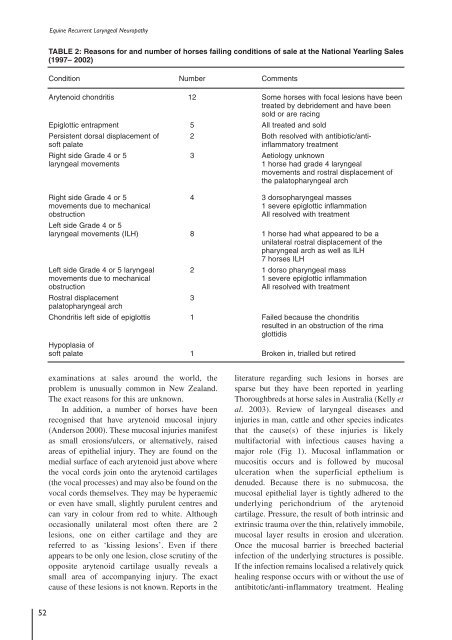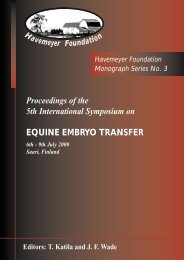Proceedings of a Workshop on - The Havemeyer Foundation
Proceedings of a Workshop on - The Havemeyer Foundation
Proceedings of a Workshop on - The Havemeyer Foundation
You also want an ePaper? Increase the reach of your titles
YUMPU automatically turns print PDFs into web optimized ePapers that Google loves.
Equine Recurrent Laryngeal Neuropathy<br />
TABLE 2: Reas<strong>on</strong>s for and number <str<strong>on</strong>g>of</str<strong>on</strong>g> horses failing c<strong>on</strong>diti<strong>on</strong>s <str<strong>on</strong>g>of</str<strong>on</strong>g> sale at the Nati<strong>on</strong>al Yearling Sales<br />
(1997– 2002)<br />
C<strong>on</strong>diti<strong>on</strong> Number Comments<br />
Arytenoid ch<strong>on</strong>dritis 12 Some horses with focal lesi<strong>on</strong>s have been<br />
treated by debridement and have been<br />
sold or are racing<br />
Epiglottic entrapment 5 All treated and sold<br />
Persistent dorsal displacement <str<strong>on</strong>g>of</str<strong>on</strong>g> 2 Both resolved with antibiotic/antis<str<strong>on</strong>g>of</str<strong>on</strong>g>t<br />
palate<br />
inflammatory treatment<br />
Right side Grade 4 or 5 3 Aetiology unknown<br />
laryngeal movements<br />
1 horse had grade 4 laryngeal<br />
movements and rostral displacement <str<strong>on</strong>g>of</str<strong>on</strong>g><br />
the palatopharyngeal arch<br />
Right side Grade 4 or 5 4 3 dorsopharyngeal masses<br />
movements due to mechanical<br />
1 severe epiglottic inflammati<strong>on</strong><br />
obstructi<strong>on</strong><br />
All resolved with treatment<br />
Left side Grade 4 or 5<br />
laryngeal movements (ILH) 8 1 horse had what appeared to be a<br />
unilateral rostral displacement <str<strong>on</strong>g>of</str<strong>on</strong>g> the<br />
pharyngeal arch as well as ILH<br />
7 horses ILH<br />
Left side Grade 4 or 5 laryngeal 2 1 dorso pharyngeal mass<br />
movements due to mechanical<br />
1 severe epiglottic inflammati<strong>on</strong><br />
obstructi<strong>on</strong><br />
All resolved with treatment<br />
Rostral displacement 3<br />
palatopharyngeal arch<br />
Ch<strong>on</strong>dritis left side <str<strong>on</strong>g>of</str<strong>on</strong>g> epiglottis 1 Failed because the ch<strong>on</strong>dritis<br />
resulted in an obstructi<strong>on</strong> <str<strong>on</strong>g>of</str<strong>on</strong>g> the rima<br />
glottidis<br />
Hypoplasia <str<strong>on</strong>g>of</str<strong>on</strong>g><br />
s<str<strong>on</strong>g>of</str<strong>on</strong>g>t palate 1 Broken in, trialled but retired<br />
examinati<strong>on</strong>s at sales around the world, the<br />
problem is unusually comm<strong>on</strong> in New Zealand.<br />
<strong>The</strong> exact reas<strong>on</strong>s for this are unknown.<br />
In additi<strong>on</strong>, a number <str<strong>on</strong>g>of</str<strong>on</strong>g> horses have been<br />
recognised that have arytenoid mucosal injury<br />
(Anders<strong>on</strong> 2000). <strong>The</strong>se mucosal injuries manifest<br />
as small erosi<strong>on</strong>s/ulcers, or alternatively, raised<br />
areas <str<strong>on</strong>g>of</str<strong>on</strong>g> epithelial injury. <strong>The</strong>y are found <strong>on</strong> the<br />
medial surface <str<strong>on</strong>g>of</str<strong>on</strong>g> each arytenoid just above where<br />
the vocal cords join <strong>on</strong>to the arytenoid cartilages<br />
(the vocal processes) and may also be found <strong>on</strong> the<br />
vocal cords themselves. <strong>The</strong>y may be hyperaemic<br />
or even have small, slightly purulent centres and<br />
can vary in colour from red to white. Although<br />
occasi<strong>on</strong>ally unilateral most <str<strong>on</strong>g>of</str<strong>on</strong>g>ten there are 2<br />
lesi<strong>on</strong>s, <strong>on</strong>e <strong>on</strong> either cartilage and they are<br />
referred to as ‘kissing lesi<strong>on</strong>s’. Even if there<br />
appears to be <strong>on</strong>ly <strong>on</strong>e lesi<strong>on</strong>, close scrutiny <str<strong>on</strong>g>of</str<strong>on</strong>g> the<br />
opposite arytenoid cartilage usually reveals a<br />
small area <str<strong>on</strong>g>of</str<strong>on</strong>g> accompanying injury. <strong>The</strong> exact<br />
cause <str<strong>on</strong>g>of</str<strong>on</strong>g> these lesi<strong>on</strong>s is not known. Reports in the<br />
literature regarding such lesi<strong>on</strong>s in horses are<br />
sparse but they have been reported in yearling<br />
Thoroughbreds at horse sales in Australia (Kelly et<br />
al. 2003). Review <str<strong>on</strong>g>of</str<strong>on</strong>g> laryngeal diseases and<br />
injuries in man, cattle and other species indicates<br />
that the cause(s) <str<strong>on</strong>g>of</str<strong>on</strong>g> these injuries is likely<br />
multifactorial with infectious causes having a<br />
major role (Fig 1). Mucosal inflammati<strong>on</strong> or<br />
mucositis occurs and is followed by mucosal<br />
ulcerati<strong>on</strong> when the superficial epthelium is<br />
denuded. Because there is no submucosa, the<br />
mucosal epithelial layer is tightly adhered to the<br />
underlying perich<strong>on</strong>drium <str<strong>on</strong>g>of</str<strong>on</strong>g> the arytenoid<br />
cartilage. Pressure, the result <str<strong>on</strong>g>of</str<strong>on</strong>g> both intrinsic and<br />
extrinsic trauma over the thin, relatively immobile,<br />
mucosal layer results in erosi<strong>on</strong> and ulcerati<strong>on</strong>.<br />
Once the mucosal barrier is breeched bacterial<br />
infecti<strong>on</strong> <str<strong>on</strong>g>of</str<strong>on</strong>g> the underlying structures is possible.<br />
If the infecti<strong>on</strong> remains localised a relatively quick<br />
healing resp<strong>on</strong>se occurs with or without the use <str<strong>on</strong>g>of</str<strong>on</strong>g><br />
antibitotic/anti-inflammatory treatment. Healing<br />
52








